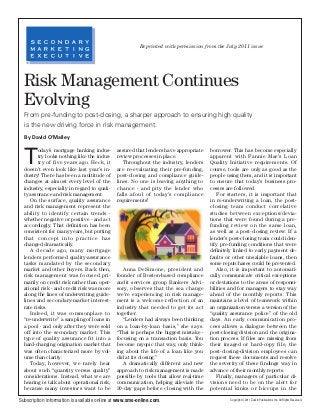Más contenido relacionado
SME Article July 2011 DO
- 1. Copyright © 2011 Zackin Publications Inc. All Rights Reserved.Subscription information is available online at www.sme-online.com.
Reprinted with permission from the July 2011 issue
T
oday’s mortgage banking indus-
try looks nothing like the indus-
try of five years ago. Heck, it
doesn’t even look like last year’s in-
dustry! There has been a multitude of
changes at almost every level of the
industry, especially in regard to quali-
ty assurance and risk management.
On the surface, quality assurance
and risk management represent the
ability to identify certain trends -
whether negative or positive - and act
accordingly. That definition has been
consistent for many years, but putting
that concept into practice has
changed dramatically.
A decade ago, many mortgage
lenders performed quality-assurance
tasks mandated by the secondary
market and other buyers. Back then,
risk management was focused pri-
marily on credit risk rather than oper-
ational risk - and credit risk was more
along the lines of underwriting guide-
lines and secondary-market interest-
rate risks.
Indeed, it was commonplace to
“re-underwrite” a sampling of loans in
a pool - and only after they were sold
off into the secondary market. This
type of quality assurance fit into a
hard-charging origination market that
was often characterized more by vol-
ume than clarity.
Today, however, we rarely hear
about such “quantity versus quality”
considerations. Instead, what we are
hearing is talk about operational risk,
because many investors want to be
assured that lenders have appropriate
review processes in place.
Throughout the industry, lenders
are re-evaluating their pre-funding,
post-closing and compliance guide-
lines. No one is leaving anything to
chance - and pity the lender who
falls afoul of today’s compliance
requirements!
Anna DeSimone, president and
founder of Boston-based compliance
audit services group Bankers Advi-
sory, observes that the sea change
we’re experiencing in risk manage-
ment is a welcome reflection of an
industry that needed to get its act
together.
“Lenders had always been thinking
on a loan-by-loan basis,” she says.
“That is perhaps the biggest mistake -
focusing on a transaction basis. You
become myopic that way, only think-
ing about the life of a loan like you
did at its closing.”
A dramatically different and new
approach to risk management is made
possible by tools that allow real-time
communication, helping alleviate the
30-day gaps before closing with the
borrower. This has become especially
apparent with Fannie Mae’s Loan
Quality Initiative requirements. Of
course, tools are only as good as the
people using them, and it is important
to ensure that today’s business pro-
cesses are followed.
For starters, it is important that
in re-underwriting a loan, the post-
closing team conduct correlative
studies between exceptions/devia-
tions that were found during a pre-
funding review on the same loan,
as well as a post-closing review. If a
lender’s post-closing team could iden-
tify pre-funding conditions that were
definitely linked to early payment de-
faults or other unsalable loans, then
some repurchases could be prevented.
Also, it is important to automati-
cally communicate critical exceptions
or deviations to the areas of responsi-
bilities and for managers to stay way
ahead of the monthly reports. This
maintains a level of teamwork within
an organization versus a version of the
“quality assurance police” of the old
days. An early communication pro-
cess allows a dialogue between the
post-closing division and the origina-
tion process. If files are missing from
their imaged or hard-copy file, the
post-closing-division employees can
request these documents and resolve
the severity of these findings way in
advance of their monthly reports.
Finally, managers of particular di-
visions need to be on the alert for
potential kinks or hiccups in the
From pre-funding to post-closing, a sharper approach to ensuring high quality
is the new driving force in risk management.
By David O’Malley
Risk Management Continues
Evolving
- 2. Copyright © 2011 Zackin Publications Inc. All Rights Reserved.Subscription information is available online at www.sme-online.com.
origination process. Something good
can actually come out of these sna-
fus: Managers can use them to re-
educate their division’s employees on
how to prevent future errors.
It is important when loans are be-
ing re-underwritten to record devia-
tions for trending purposes.
Post-closing divisions are compiling
these trends and, more importantly,
the frequency of critical deviations or
exceptions that are causing loans to
be unsalable.
Once the action plan is in place, the
risk-management team can compile
trending analysis to see if the frequen-
cy of these deviations is diminishing
with the re-education on the front-
end processes. If deviations are going
away, then the action plan, as well as
the teamwork, was effective.
Further, those metrics can be bro-
ken up into segments representing
low, moderate, high or prohibitive er-
rors. All of this is good news for risk
management with higher levels of
quality control - which, of course, is
important in today’s intensive regula-
tory environment. SME
David O’Malley is president of ACES Risk
Management Corp., based in Fort Lauderdale,
Fla. He can be reached at (954) 202-5606.
